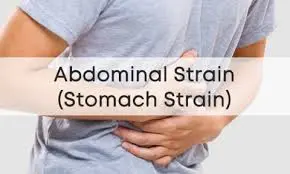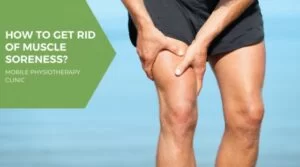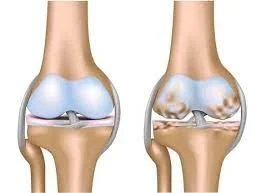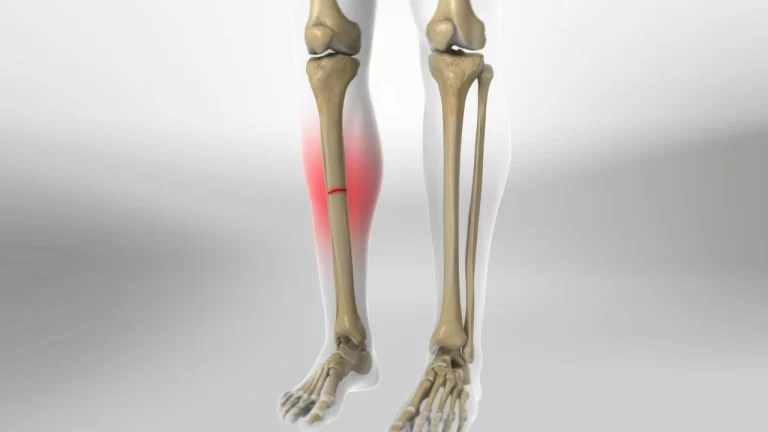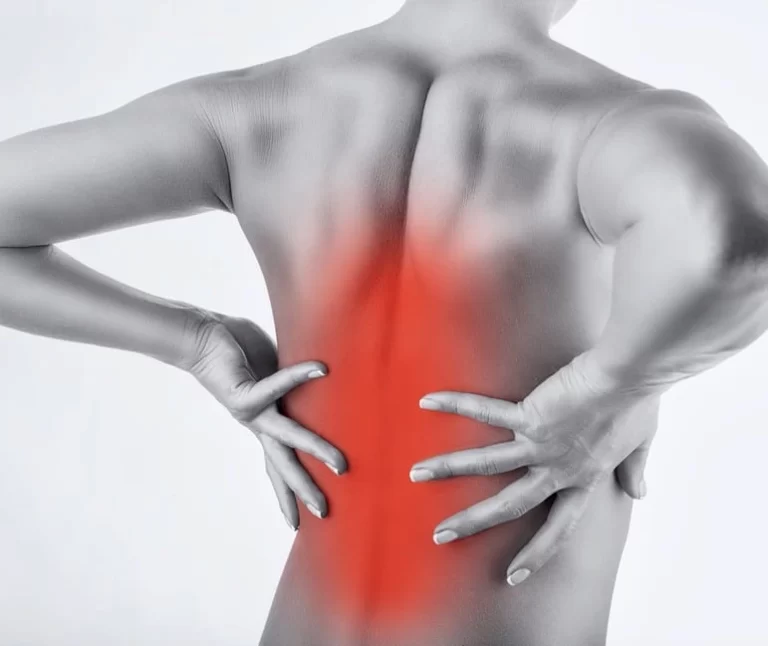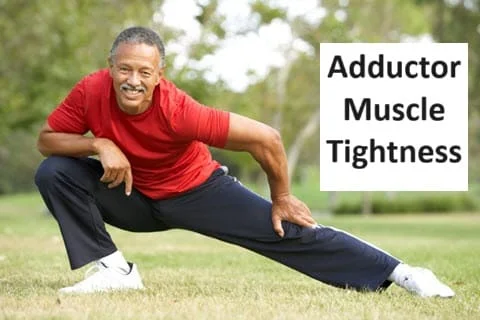Pulled Stomach Muscles
Pulled stomach muscles, also known as abdominal muscle strains, are a common source of discomfort and pain in individuals of all ages and activity levels. These injuries occur when the muscles in the abdominal region are stretched or torn due to overexertion, sudden movements, or excessive strain
What is Pulled Stomach Muscle?
An injury to the muscles of the abdominal wall is referred to as a pulled stomach muscle or abdominal muscle strain. The set of muscles known as the abdominal muscles serve as the body’s center of support and stability. For tasks like bending, twisting, and lifting, they are essential.
When the muscles that make up the abdominal wall are stretched or ripped as a result of excessive force or overuse, it results in a pulled stomach muscle. This can take place when doing things like heavy lifting, playing sports, or even just coughing or sneezing. A torn stomach muscle may cause abdominal pain or discomfort, edema, bruising, and difficulties bending or moving.
In order to lessen pain and swelling, RICE protocol is frequently used to treat pulled stomach muscles. To aid with symptom management and injury prevention, physical therapy and pain medications may also be prescribed.
Surgery could be required in critical situations to heal a ruptured stomach muscle. However, cautious approaches, adequate rest, and care may effectively treat the majority of pulled stomach muscles.
What are the stomach muscles?
The musculoskeletal system includes the abdominal (stomach) muscles. These muscles support the trunk (midsection), maintain the organs in place, and aid in movement on the front of the body, between the pelvis and the ribs.
The set of muscles that make up the abdominal wall is known as the abdominal muscles. They consist of:
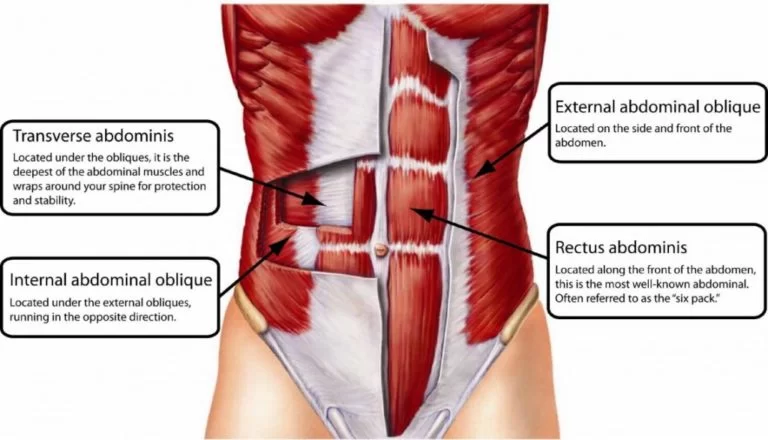
- Rectus abdominis: The most well-known abdominal muscle, the rectus abdominis, is often referred to as having a “six-pack.” It controls the trunk’s flexion and runs vertically along the front of the abdomen.
- External obliques: The muscles that turn the trunk are called external obliques, and they run diagonally from the lower ribs to the pelvis.
- Internal obliques: These muscles rotate the trunk in a similar manner as the external obliques, except they run diagonally in the opposite direction.
- Transversus abdominis: This muscle compresses the abdominal contents and travels horizontally across the abdomen.
Together, these muscles support and stabilize the spine and pelvis and help the body move the trunk and limbs. They are engaged in several daily activities including bending, twisting, and lifting as well as posture, breathing, and digesting.
Where do pulled stomach muscles occur?
The rectus abdominis muscle, which is situated at the front of the abdomen and is sometimes referred to as the “six-pack” muscle, is where abdominal muscular strains most frequently occur. Heavy lifting, twisting, and rapid movements are among the activities that regularly cause this muscle to get strained.
The oblique muscles, which are on the sides of the abdomen and aid in twisting and bending, and the transverse abdominis muscle, which is deep inside the belly and aids in stabilizing the spine and pelvis during movement, are two additional places where abdominal muscle strains can develop.
What are the signs and Symptoms of a Pulled Stomach Muscle?
Pain in the region of the pulled muscle is the major sign of a strained ab muscle. The discomfort may be in the upper, middle, lower, right, or left side of your abdomen, depending on the muscle that is hurt.
The abdominal muscles are divided into four groups:
- Rectus abdominis: The “six-pack” abs are made up of this long, flat muscle that runs down the middle of your body from the bottom of your rib cage to your pubic bone.
- External obliques: The side muscles, known as the external obliques, extend diagonally from the top of your hip bones to the center of your ribs.
- Internal obliques: Deeper side muscles on each side of the hipbone’s front that attach to the lower ribs are called internal obliques.
- Transversus abdominis: The deepest layer of your abs is called the transversus abdominis, and it is a horizontal belt of muscle that, like a corset, wraps around your body from the ribs to the pelvis.
These muscles help to flex the spine, rotate the body, and stabilize the midsection. When you move in different directions, tension in these muscles may produce discomfort.
The injury’s local region, a larger one, or even your back, hip, or groin may be painful. Additional signs of an abdominal muscle strain include:
- Difficulty engaging your core muscles
- Muscle cramps
- Muscle spasms
- Muscle tenderness
- Muscle weakness
- Swelling and inflammation
What are the classifications of Pulled Stomach muscles?
Grade 1 Pulled Stomach Muscle: First-degree abdominal strains are classified as Grade 1 pulled stomach muscles and are characterized by modest muscular straining that causes localized pain, little edema, and pain with movement, coughing, laughing heavy breathing, or sneezing.
Grade 2 Pulled Stomach Muscle: A partial tear, often known as a second-degree tear, is a more serious damage to the abdominal muscles. The athlete may be severely disabled by this sort of injury, depending on how many fibers were ripped. The athlete could also notice noticeable discomfort, localized edema, and discoloration in addition to abrupt stomach pain. The athlete may experience discomfort with any and all moves if they are cautious.
Grade 3 Pulled Stomach Muscle: A complete muscular rupture at the insertion, origin, or middle characterizes a third-degree muscle strain, which is the most serious damage. The athlete may also feel shock symptoms such as nausea, vomiting, pale complexion, excessive sweating, trouble breathing, and a shallow and quick heartbeat in addition to the signs of a second-degree muscular strain. Athletes who may have a full rupture muscle tear should be taken out of the game right once and given emergency care until help arrives. While an ice pack is being administered to the injury, the athlete should be held motionless. Up until aid comes, the athlete’s vital signs (pulse, respiration, and blood pressure) should be watched.
What are the Causes of a Pulled Stomach Muscle?
An abdominal muscular strain, often known as a pulled muscle, can result from overusing or repeatedly straining the abdominal muscles, as well as from rapid or severe abdominal muscle contractions.
The following are a few typical reasons for abdominal muscle strain:
- Overexertion during exercise: Muscle strains can result from performing demanding exercises or abrupt movements, such as lifting heavy objects or performing sit-ups, without the necessary warm-up or technique.
- Poor posture: For extended periods of time, sitting or standing with poor posture can strain the abdominal muscles excessively.
- Incorrect lifting technique: Lifting large things improperly can strain the abdominal muscles, particularly if the weight is raised with the back muscles rather than the legs.
- Age: As we become older, our muscles lose flexibility and become more prone to injury.
- Injury in the past: An earlier abdominal muscular strain may have weakened the muscles, leaving them more prone to a repeat injury.
- Medical problems: Some medical issues, such as muscular imbalances, a weak core, or weak abdominal muscles, might raise the risk of an abdominal muscle strain.
- A rapid cough or sneeze, as well as being struck in the belly, can also strain the abdominal muscles.
The region should be given some time to heal while you stay away from any activities that might worsen an abdominal muscle strain. Additionally, ice and anti-inflammatory drugs can help reduce discomfort and swelling. It is advised to take medical treatment if symptoms continue.
What is the difference between a Pulled Stomach Muscle & a Hernia?
An injury to the abdominal muscular fibres known as a pulled stomach muscle can result from overstretching or overusing the muscle. Pain, swelling, and restricted movement are possible symptoms; however, they often go away with rest and self-care techniques including ice, heat, and mild stretching.
A hernia, on the other hand, happens when an organ or piece of tissue pushes through a weak spot in the abdominal wall. A persistent cough, hard lifting, or heredity are just a few of the possible causes. A noticeable mass or protrusion in the belly, pain or discomfort, and nausea or vomiting are possible symptoms. A hernia, in contrast to a strained muscle, won’t go away on its own and may need surgery to be fixed.
In conclusion, both a pulled stomach muscle and a hernia can result in abdominal pain and discomfort. However, a pulled muscle is an injury to the muscle that usually goes away with rest and self-care, whereas a hernia is a protrusion of an organ or tissue that needs medical attention and may need to be repaired surgically.
How are pulled stomach muscles diagnosed?
A strained stomach muscle can be identified by your doctor based on your symptoms and a physical examination. You could experience: Depending on the injury’s etiology and your symptoms:
- X-rays to look for spine fractures, rib injuries, or other fractured bones.
What is the treatment of Pulled stomach muscles?
Immediate Treatment:
Employing the P.R.I.C.E. principle (Protection, Rest, Ice, Compression, Elevation) is crucial, starting with the application of a cold therapy pad or ice pack to the abdominal area for twenty minutes. The ice pack can be reapplied every 2 hours for the 1st 2-3 days after injury.
Rest is another integral aspect of the P.R.I.C.E. principle, although it poses more challenges with an abdominal strain. Injuries to the limbs can easily be protected and rested using crutches, slings, or braces, but immobilizing the trunk of the body is a more complex task.
Activity Limitation:
To safeguard and rest the abdominal muscles, the athlete may need to curtail their activities for a few days until the pain subsides.
Utilize an Abdominal Compression Pad:
To provide support to the injured area, the athlete may opt to wear a stomach compression pad. This pad also aids in reducing swelling through added compression.
Gentle Stretching:
Once the pain begins to diminish, the athlete can initiate mild stretching of the injured area, along with isometric contractions to commence the process of strengthening and healing the injured tissue. Stretching should be gradual and performed cautiously to avoid inducing pain. Pain serves as an indicator that the athlete has exceeded the capacity of the injured tissue to elongate.
Premature stretching during the rehabilitation of a muscle strain can re-injure the damaged tissue and impede the athlete’s progress. New collagen tissue may detach from its attachment point, restarting the bleeding and swelling process.
Isometric Muscle Exercises:
These exercises can be safely conducted early in the rehabilitation process since they entail contracting a muscle without moving the associated joints. An example is having the athlete lie on their back, flex their knees, and place their feet on the ground. Then, they push their lower back against the ground while simultaneously contracting all abdominal muscles. The squeeze can be maintained for 10 seconds & repeated 10 times. As the muscle continues to heal and the athlete’s range of motion improves, they can advance to concentric muscle exercises for their core.
Concentric Muscle Exercises:
These exercises involve muscle contraction, resulting in the shortening of the muscle and movement of adjacent joints. To enhance the strength of all abdominal muscle groups, include movements like trunk flexion, rotation, and lateral flexion (side bending). Each exercise should target specific muscle groups. Sit-ups, once popular for strengthening the rectus abdominis, are not the most effective exercise.
A modified crunch is a better choice. The athlete lies on the floor with knees bent and feet shoulder-width apart, contracts the abdominals, and then lifts their chest toward the ceiling, emphasizing a lift rather than a curl. To target the internal and external obliques, the same exercise can be performed with a rotational component, alternately rotating to the left and right with each modified crunch. This rotational element targets the diagonal fibers of the internal and external obliques. Standard core exercises can be executed to strengthen the stomach muscles. If available, core exercises can be performed using a therapy ball or foam roll.
Here is a helpful video demonstrating how to effectively treat a pulled stomach muscle.
Recovery: Getting back to Sport
Once the athlete achieves pain-free full range-of-motion for their trunk, encompassing flexion, extension, rotation, and lateral flexion, along with significant strength, they are prepared to advance to sport-specific functional exercises.
These exercises should encompass a gradual progression of skills tailored to the athlete’s particular sport. For instance, a softball player should incorporate offensive and defensive drills specific to their position. Consider a catcher who should engage in position-specific drills, while a middle infielder should practice fielding balls directed straight at them and to either side.
Regardless of the defensive role, all baseball players must master the art of swinging a bat. Individuals recovering from a pulled stomach muscle should exercise extra caution when commencing and advancing through hitting drills. The athlete should initially engage in swinging drills at around 50% intensity, using a lighter bat than usual. As soon as they can execute full-speed bat swings without discomfort, they can progress to hitting whiffle balls off a tee or engage in soft toss drills.
Once these drills are comfortably and confidently executed, the athlete can move on to hitting off a machine. Only when the athlete can proficiently perform all the fundamental skills required by their sport without experiencing pain should they consider transitioning to scrimmage situations. Over time, bolstered by confidence, the athlete will be well-prepared for a successful return to competitive sports.
How to prevent future abdominal strain?
Strengthening core muscles is imperative, especially for individuals recovering from a pulled stomach muscle. The good news is that many sports programs already integrate core strength training exercises into their conditioning regimens. However, for those in programs lacking such training, a wide array of core exercises is readily available, often recommended by personal trainers, physical therapists, and certified athletic trainers. These professionals can offer additional or advanced exercises to fortify core muscles. Here are some effective at-home abdominal exercises:
- The Bridge: This core exercise can be performed without any equipment. It’s straightforward and offers numerous variations to increase the exercise’s difficulty. Start with a supine lying position with your knees flexed, & feet flat on the bed. Lift your pelvis off the ground until your knees, hips, and spine form a straight line. Initially, you can keep your hands and arms on the floor for added stability. As you gain strength, try raising your arms off the floor while in the bridge position. During the bridge, engage all the muscles around your trunk and hold for 10 seconds. Do repeat this for 3 sets of 10 repetitions. To intensify the exercise, you can extend one knee by lifting your foot off the ground while maintaining a neutral pelvis position, with hips straight and not rotated. Alternate legs or hold the extended leg for a count of five or ten before placing your foot back on the ground.
- The Plank: Another effective exercise for building core strength, the plank is performed on the ground with your forearms supporting your body in a push-up position. If this is too challenging, you can start in the plank position on your knees. Your goal is to maintain the plank position for as long as possible while keeping your spine, hips, knees, and feet aligned in a straight line. To increase the difficulty, a transition from a forearm position to a push-up place by alternately pushing up one arm and then the other, then reversing back to the forearm position, all while keeping your hips and shoulders stable during the movement.
- The Side Plank: This alternative to the regular plank has the same core-strengthening benefits. In this exercise, you lie on your side, balancing on one forearm while holding your opposite arm up in the air, ensuring your body remains straight, with only your feet touching the ground. A more challenging variation involves lifting your top leg while maintaining a tight core in the plank position. You can do this by performing multiple leg lifts or by holding the leg lift for several seconds.
- The Traverse Ab Press: This exercise is demonstrated in the following video.
Conclusion
A pulled stomach muscle can lead to a range of discomfort, from mild inconvenience to severe pain that hampers everyday activities. This type of muscle injury occurs when muscle fibers are strained due to factors like sports-related incidents, overuse, or insufficient muscle conditioning.
Fortunately, most cases of a pulled stomach muscle can be effectively managed with at-home care. The initial treatment typically involves rest and applying ice. After the first three days, you can incorporate gentle stretching exercises. As your condition improves, you can gradually increase your physical activity.
However, if the pain is severe, significantly disrupts your ability to function, or shows no signs of improvement even after a week of home care, it’s advisable to seek consultation with your healthcare provider. In some instances, treatment options such as physical therapy or surgery may be necessary to address a pulled stomach muscle.
The duration of your recovery from a pulled stomach muscle depends on the severity of the injury. Milder strains usually resolve within one to two weeks, while more severe strains may require several months for a complete recovery.
FAQ
How long does a pulled stomach muscle take to recover?
However, some people could need surgery. The degree of a pulled muscle will influence how quickly it heals. While a more severe pulled muscle may take 4 to 6 weeks to recover, a mildly strained muscle may usually mend in a few weeks.
How do you treat a pulled stomach muscle?
An abdominal muscle strain is typically treatable with rest, ice, compression, and over-the-counter painkillers. However, if any of the following occur, you should go to the emergency room: stomach pain that is sudden or severe and does not go away with rest or painkillers.
Is it a hernia or a pulled muscle?
Your chance of developing a hernia may rise if your abdominal muscles are strained. Both a pulled stomach muscle & a hernia can result in stomach ache. Hernias result in a lump or protrusion that may hurt or burn at the hernia site. In addition to these problems, a hernia can even result in nausea & vomiting.
How long does muscle strain last?
Almost all Grade I strains often recover in a matter of weeks, however, Grade II strains may require up to three months to cure. After several months of rehabilitation following surgery to treat a Grade III strain, the majority of patients regain normal muscular function.
What are the 4 stages of muscle healing?
The several stages of muscle repair and regeneration, including degeneration, inflammation, regeneration, remodeling, and maturation, are explained in this succinct summary.

